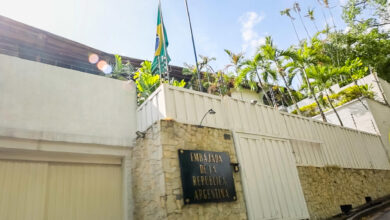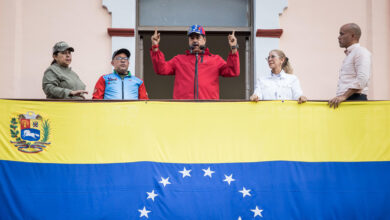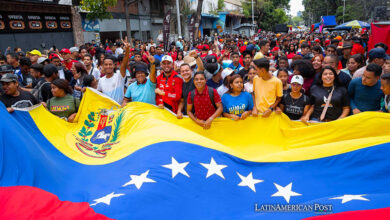How to Understand Latin America Through the Figure of Hugo Chávez?
Ten years after the death of Hugo Chávez, we analyze his influence on the construction and configuration of the current Latin American region.

Photo: Argentine Presidency
LatinAmerican Post | Luis Angel Hernández Liborio
Listen to this article
Leer en español: ¿Cómo entender a Latinoamérica a través de la figura de Hugo Chávez?
The leftist configuration of Latin America cannot be understood without the influence and "legacy" of one of the most influential figures in the world in the 21st century: Hugo Chávez. "El Comandante," as he was also known, left his ideas, ideals, and projects in the region that reached an echo in all latitudes. Regardless of whether the perception of Chavismo is positive or negative, its weight in understanding the processes that have shaped the current situation in the region cannot be denied.
Chávez Died but Chavismo Continues
Hugo Chávez died in March 2013, that is, a decade ago. However, his "shadow" remains present in the region's politics, beginning no doubt with Venezuela, a country that still survives the post-Chávez era. Although Nicolás Maduro started with the "blessing" of Chavismo, over time, it has blurred it and made this current's negative aspects more visible. One of the most prosperous countries in the region, Venezuela, is now sustaining itself in a deep economic, political and social crisis. The country's course is still unclear, but Maduro tries to vindicate Chavismo through him. However, it has put it at risk, so the continuity of the Chavista legacy is clearly at risk.
Meanwhile, according to the International Monetary Fund, millions of Venezuelans (seven million since 2015) have left the country in one of the worst humanitarian crises this century. Migrants have found countries that are less and less open to receiving them, mainly due to causes such as the health crisis and its subsequent economic effect, without neglecting xenophobia. Although the Maduro government deteriorated the delicate financial stability of Chavismo, its creator had already laid the foundations for economic chaos with his autocratic government and the disagreement with sectors such as business.
The Chavista Vision of Latin America
Chávez was part of Latin America's so-called "first wave" of the left. "El Comandante" coincided with characters like Lula da Silva in Brazil, the Castro brothers in Cuba, the Kirchners in Argentina, Rafael Correa in Ecuador, Pepe Mujica in Uruguay, Michelle Bachelet in Chile, Evo Morales in Bolivia and Daniel Ortega in Nicaragua. With them, he created an axis that reinforced the idea of Latin American unity, organizations such as Mercosur and the Andean Community were strengthened, and the Community of Latin American and Caribbean States (CELAC) was created through the Caracas Declaration in 2011. With this, he sought to counterbalance the power of the OAS led by the United States and the Free Trade Area of the Americas (FTAA) against which the Bolivarian Alliance for the Peoples of Our America (ALBA) was specially generated.
The Venezuelan president promoted unity by appealing to Simón Bolívar's dream of a single Latin American nation. Although he did not achieve it, he did generate counterweights and interlocutors against the power of the OAS and the United States. CELAC continues to be a watershed in Latin America's relationship with the European Union, China, and Russia, mainly something that countries like Cuba and Central American and Caribbean nations could hardly achieve individually. It is also worth saying that the voice he gave to countries excluded from the OAS was considered harmful by organizations in defense of democracy and human rights, as well as by countries like the United States, Mexico, and Colombia (oriented to the right at that time). Who considered Venezuela a dictatorship that helped sustain others.
With economic and energetic support, this alternative Latin America that he created managed to sustain the power of the Castros in Cuba and consolidate Morales in Bolivia. In addition, he had no qualms about supporting leftist leaders in the region. However, it was more damaging than beneficial in cases like that of López Obrador in Mexico. The right played the "Venezuelanization" card to scare the electorate, who fell into the trap. Chávez was also someone close to characters like Gustavo Petro, the current Colombian president, who also had an electoral weight in his country for his closeness to Chavismo.
You can also read: El Salvador: Mega prisons, a real solution against crime?
Chávez, Peace for Colombia
If there is a country with a comparative history with Hugo Chávez, it is Colombia. The neighborhood with Chavismo had (and continues to have) an inevitable economic and social influence, both for better and worse. The long peace process in Colombia with the different illegal armed forces had the support of Hugo Chávez, who was a defender of the search for an agreement and supported the release of people kidnapped by the FARC. In the last stage of his life, together with Juan Manuel Santos, he promoted the talks in Havana that would end in the historic agreement, which, although Chávez failed to see completed, he was an actual figure. But Chávez was a figure with chiaroscuro. At the same time that he captured drug lords and supported the Colombian peace process, he was also accused of leading an extensive and sophisticated drug trafficking network to bring cocaine to the United States and financing the FARC.
His belligerent personality, charisma, and anti-American thinking made him a perfect target for the right, who branded him a dictator. His break with the United States and the influence he exercised in the region elevated him as an almost untouchable character, so despite the northern power putting pressure on his close circle, the Venezuelan president continued to wield incredible power that left Nicolás Maduro almost intact. Although the loss of influence and power is notable, the Chavismo that seemed to be in decline revived with the "new wave" of the left, although in moderation, nobody wants to have the shadow of Chávez in their governments. Chávez's successor remains in control by appealing to the figure of the former president.





